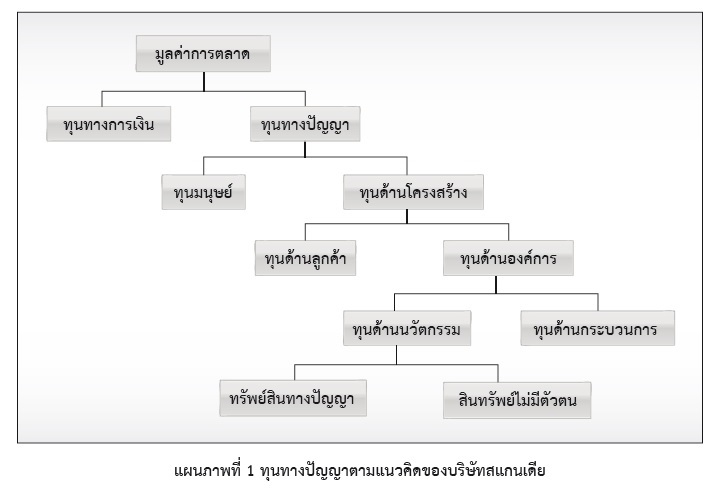ทุนมนุษย์ : ขุมพลังและศักยภาพการแข่งขันของประเทศไทย
คำสำคัญ:
Human Capital, Human Resource Management, Functional Citizenry, Investment in Educationบทคัดย่อ
บทวิจัยนี้เป็นการวิจัยเชิงคุณภาพด้วยการสังเคราะห์เอกสารและวิเคราะห์เชิงเนื้อหาแบบปริทัศน์พรรณนาเกี่ยวกับทุนมนุษย์ การลงทุนและผลตอบแทนในเชิงรายได้ กล่าวโดยสรุป ทุนมนุษย์เป็นปัจจัยสำคัญในการบริหารจัดการขององค์กร เพื่อให้สามารถรับมือกับกระแสการเปลี่ยนแปลงที่มีความผันผวนอย่างมาก จากยุคของ Adam Smith จนถึง Nelson Mandela ล้วนมองว่าการศึกษาเป็นเครื่องมือสำคัญในการขับเคลื่อนการเปลี่ยนแปลงทั้งด้านเศรษฐกิจและสังคม อีกทั้งยังเป็นทุนปัจจัยการผลิตที่สำคัญ และกลายเป็นดัชนีชี้วัดศักยภาพการแข่งขันของประเทศ และการประมวลแนวคำสอนและการดำ เนินชีวิตตามรอยพระยุคลบาทของพระบาทสมเด็จพระเจ้าอยู่หัวรัชกาลที่ 9 ทำ ให้เกิดเป็นรูปแบบการพัฒนาทุนมนุษย์ที่พึงประสงค์สำ หรับสังคมไทย
เอกสารอ้างอิง
ทนง พิทยะ (เมษายน 2561). บทสัมภาษณ์ความเห็นต่อทุนมนุษย์และแนวทางการพัฒนา.
มณีวรรณ ฉัตรอุทัย. (พฤศจิกายน 2560). การศึกษาเชิงสำ รวจค่านิยม: กรณีศึกษาค่านิยมในสังคมไทยตามรอยพระบาทศาสตร์แห่งพระราชา. วารสารบริหารธุรกิจนิด้า. เล่มที่ 21. หน้า 5-17.
ลิขิต ธีรเวคิน (เมษายน 2558). การศึกษาที่กำลังจะกลายเป็นโรงงานผลิตใบปริญญา. Retrieved from http://www.moe.go.th/moe/th/news/detail.php?NewsID=41317&Key=news_research
Middle Income Trap: กับดักเศรษฐกิจที่รอการก้าวข้าม. Retrieved from http://www.bangkokbiznews.com/blog/detail/643029
Amble, B (2003, Feb 21). CFOs want greater role in managing human capital. Management issues.
Retrieved from http://www.management-issues.com/news/493/cfos-want-greater-role-inmanaging-human-capital/
Baptiste, I. (2001). Educating lone wolves: Pedagogical implications of human capital theory. Adult Education Quarterly, 51(3), 184–201.
Becker, G. (1964) Human Capital: A Theoretical and empirical analysis, with special reference to education. Cambridge, MA: Harvard University Press.
Benhabib, J, & Spiegel, M.M. (1994). The role of human capital in economic development: Evidence from aggregate cross-country data. Journal of Monetary Economics, 34, 143-173.
Chat-uthai, M. (2013, November). Quality Movement: Challenges or constraints on Thailand’s education. NIDA Business Journal, (13), 113-114.
Bok, D. (1975, October 6). Washington Post, Ann Landers Column. Retreived from https://www.quora.com/Who-said-If-you-think-education-is-expensive-try-ignorance
Edvinsson, L. (1997). Developing intellectual capital at Skandia. Long range planning, 30 (3), 366-373.
Gurteen Knowledge Log (2017, June). The future starts in 14 seconds. Retrieved from http://www.gurteen.com/gurteen/gurteen.nsf/id/future-centers
Human Capital Index (2016). Retrieved from http://reports.weforum.org/human-capital-report-2016/east-asia-and-the-pacific/
Inoue, K. (1985). Education & training of industrial manpower in Japan. Washington D. C.: World Bank Publication.
Investopedia. (2017). Retrieved from https://www.investopedia.com/terms/h/humancapital.asp#ixzz4z9hVMalf
Lucas, R. E. Jr. (1988). On the mechanics of economic development. Journal of Monetary Economics, 22(1), 3-42.
Mandela, N (2017). Retrieved from http://nelsonmandelas.com/nelson-mandela-education/
Mankiw, N. G., Romer, D, & Weil, D. N. (1992, May). A contribution to the empirics of economic growth. Quarterly Journal of Economics, pp. 407-409.
Mincer, J (1981). Human capital and economic growth. National Bureau of Economic Research, Working Paper, No.803.
Nelson, R.R. & Phelps, E.S. (1966, May). Investment in humans, technological diffusion, and economic growth. American Economic Association Papers and Proceedings, 56, 69-75.
Nurkse, Ragnar. (1953). Problems of Capital Formation in Underdeveloped Countries. Oxford: Oxford University Press.
OECD (2017). Relative earning by education attainment: Upper secondary. Retrieved from https://stats.oecd.org/Index.aspx?DataSetCode=EAG_EARNINGS
Patterson, K.D. & Schott, K. (1979). The Measurement of capital: Theory and practice. Palgrave Macmillan UK.
Phillips, J. J. (2005). Investing in your company’s human capital. New York: AMACOM.
Pigou, A. C (1928). A Study in Public Finance. London: Macmillan.
Power, S. (2016, October 28). Remarks at a UN General Assembly Tribute to the Memory of His Majesty King Bhumibol Adulyadej. Retrieved from https://th.usembassy.gov/remarksambassador-samantha-power-un-general-assembly-tribute-memory-majesty-king-bhumiboladulyadej/
Scherkenbach, W.W. (1994). The Deming route to quality and productivity: Road maps and roadblocks. WWS, Inc.
Schultz, T. W. (1975). The value of the ability to deal with disequilibrium. Journal of Economic Literature, 13(3), 827-846.
Schultz, T.W. (1979, December 8). Prize Lecture on The Economics of Being Poor. Retrieved from https://www.nobelprize.org/nobel_prizes/economic-sciences/laureates/1979/schultz-lecture.html
Smith, A. (1976). The wealth of nations. Retrieved online from http://political-economy.com/wealthof-nations-adam-smith/
Spalletti, S. (2014). The economics of education in Adam Smith’s wealth of nations. Journal of World Economic Research. Vol. 3, No. 5, 60-64.
Spence, M. (2002). Signaling in retrospect and the informational structure of markets. American Economic Review, 92(3), 434–459.
Spence, M. 1973, ‘Job Market Signaling’, The Quarterly Journal of Economics, vol. 87, pp. 355-374.
TDRI Report (2015, January). Attitude change of the public sector to enhance competitiveness. Report No. 111
The Economist (2017, Aug 3). Retrieved from https://www.economist.com/news/economicsbrief/21725757-becker-made-people-central-focus-economics-second-our-series-big
Tittenbrun, J. (2014). Concepts of capital: The Commodification of social life. New Brunswik, NJ: Transaction Publishers.
U.S. Bureau of Statistics. (2017, October 18). Weekly earnings age 25 and over. Retrieved from https://www.bls.gov/news.release/pdf/wkyeng.pdf
UNESCO Institute for Statistics. (2017). Education on GDP and investment in R & D.
Retrieved from https://stats.oecd.org/Index.aspx?DataSetCode=EAG_EARNINGS
UNESCO Publishing (2015). Education for All 2000 - 2015: Achievements and challenges.
Retrieved from http://unesdoc.unesco.org/images/0023/002325/232565e.pdf
WEF The Future of Jobs Survey (2016). Skills stabilityWEF 2016. Retreived from http://reports.weforum.org/future-of-jobs-2016/skills-stability/
World Economic Forum (2017). The Global competitiveness report 2017-2018. Retrieved from http://reports.weforum.org/global-competitiveness-index-2017-2018/
Wozniak, G. (1984). The adoption of interrelated innovations: A human capital approach. Review of Economics and Statistics, 66(1), 70-79.

ดาวน์โหลด
เผยแพร่แล้ว
รูปแบบการอ้างอิง
ฉบับ
ประเภทบทความ
สัญญาอนุญาต
ลิขสิทธิ์ (c) 2024 คณะบริหารธุรกิจ สถาบันบัณฑิตพัฒนบริหารศาสตร์

อนุญาตภายใต้เงื่อนไข Creative Commons Attribution-NonCommercial-NoDerivatives 4.0 International License.



